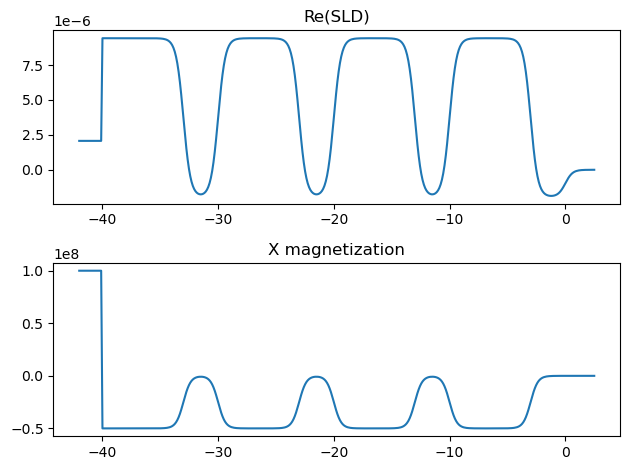1
2
3
4
5
6
7
8
9
10
11
12
13
14
15
16
17
18
19
20
21
22
23
24
25
26
27
28
29
30
31
32
33
34
35
36
37
38
39
40
41
42
43
44
45
46
47
48
49
50
51
52
53
54
55
56
57
58
59
60
|
#!/usr/bin/env python3
"""
Plot SLD and magnetization profiles for a
multilayer sample with rough interfaces.
"""
import bornagain as ba
from bornagain import angstrom, ba_plot as bp, R3
import numpy as np
import matplotlib.pyplot as plt
def get_sample():
# materials
vacuum = ba.MaterialBySLD("Vacuum", 0, 0)
material_ti = ba.MaterialBySLD("Ti", -1.9493e-06, 0)
B_ni = R3(-5e7, 0, 0)
material_ni = ba.MaterialBySLD("Ni", 9.4245e-06, 0, B_ni)
B_substrate = R3(1e8, 0, 0)
material_substrate = ba.MaterialBySLD("SiSubstrate", 2.0704e-06, 0,
B_substrate)
# layers
ambient_layer = ba.Layer(vacuum)
ti_layer = ba.Layer(material_ti, 30*angstrom)
ni_layer = ba.Layer(material_ni, 70*angstrom)
substrate_layer = ba.Layer(material_substrate)
# sample
sample = ba.MultiLayer()
sample.addLayer(ambient_layer)
roughness = ba.LayerRoughness(5*angstrom, 0.5, 10*angstrom)
for _ in range(4):
sample.addLayerWithTopRoughness(ti_layer, roughness)
sample.addLayerWithTopRoughness(ni_layer, roughness)
sample.addLayer(substrate_layer)
return sample
if __name__ == '__main__':
sample = get_sample()
n_points = 400
z_min, z_max = ba.defaultMaterialProfileLimits(sample)
z_points = ba.generateZValues(n_points, z_min, z_max)
sld = ba.materialProfileSLD(sample, n_points, z_min, z_max)
mag_X = ba.magnetizationProfile(sample, "X", n_points, z_min, z_max)
plt.subplot(2, 1, 1)
plt.plot(z_points, np.real(sld))
plt.title("Re(SLD)")
plt.subplot(2, 1, 2)
plt.plot(z_points, mag_X)
plt.title("X magnetization")
plt.tight_layout()
bp.show_or_export()
|
 BornAgain
≻ 21
≻ Documentation ≻ Script examples ≻ Plot and export ≻ SLD profile ≻ SLD profile with rough interfaces
BornAgain
≻ 21
≻ Documentation ≻ Script examples ≻ Plot and export ≻ SLD profile ≻ SLD profile with rough interfaces
